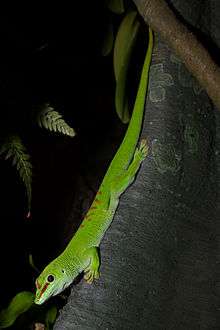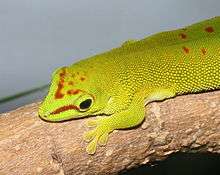Phelsuma grandis
| Phelsuma grandis | |
|---|---|
 | |
| Scientific classification | |
| Kingdom: | Animalia |
| Phylum: | Chordata |
| Class: | Reptilia |
| Order: | Squamata |
| Family: | Gekkonidae |
| Subfamily: | Gekkoninae |
| Genus: | Phelsuma |
| Species: | Phelsuma grandis |
| Binomial name | |
| Phelsuma grandis Gray, 1870 | |
 | |
| Synonyms | |
|
Phelsuma madagascariensis subspecies grandis Gray, 1870 | |
Phelsuma grandis Gray, 1870, is a diurnal arboreal species of day gecko (Phelsuma spp.). These geckos are part of the Phelsuma group, which consists of in excess of 70 species and subspecies. They are commonly referred to as the Madagascar giant day gecko, due to their large size. They are native to areas of tropical and subtropical forest in northern Madagascar, but have been introduced to several other subtropical locations outside their range. P. grandis feeds on various invertebrates, very small vertebrates, and nectars.
Taxonomy
Its generic name is a Latinized version of the last name of Dutch physician Murk van Phelsum.[2] Its specific name grandis is Latin for "great".
The species Phelsuma grandis described by Gray 1870 was elevated from subspecies status (P. madagascariensis grandis) by Raxworthy et al. in 2007,[3] after environmental niche modeling revealed significant and reliable differences between it and other members of the P. madagascariensis-clade. This elevation has since received further molecular support.[4] P. grandis possesses also the junior synonyms Phelsuma madagascariensis venusta Mertens, 1964 and Phelsuma madagascariensis notissima Mertens, 1970 (fide Meier, 1982). The common name, appended to the current accepted name, has been given as Madagascar giant day gecko or variants such as Giant Day Gecko.[5]
Description

This lizard reaches a total length of 30 centimetres (12 in). The body colour is bright green or, rarely, bluish green. A red stripe extends from the nostril to the eye. On the back there are typically red coloured dots or bars. These red markings are quite variable, and in some cases, completely absent, though the line extending from the nostril to the eye is always present. Some specimens may have small blue spots. Adult specimens may have large sacs on their necks. These are stored calcium sacks. Young individuals of the species often exhibit much more red than their parents, but as time passes, many of the markings fade, to leave those that will stay for the remainder of the gecko's life. The underside of these animals is a creamy white ranging to an eggy yellow. When stressed, the colouration darkens, rendering the whole animal a dark green, and the red markings on the face and back more orange in hue.[6]
Distribution and habitat

This species is widely distributed in northern and northwest Madagascar.[7] It can also be found on some of the off shore islets or palms, e.g. Seychelles (on Lodoicea). There are a few recorded populations of this species also in Florida[8][9] and Hawaii.[10] It was introduced to Reunion Island in the mid-1990s and can be found in Mauritius, mainly in Floreal and in the upper Plain Wilhems.[11]
Diet
These day geckos feed on various insects and other invertebrates, and occasionally have been recorded consuming small vertebrates. They also like to lick soft, sweet fruit, pollen and nectar.[5] Geckos in the wild and in captivity have been observed consuming their own young.[12]
Behaviour
Like most Phelsuma species, the males can be quite quarrelsome and territorial and will not accept other males in their neighborhood. They only allow females to enter their territory. In captivity, where the females cannot escape, the males can also sometimes seriously wound a female. In this case the male and female must be separated. Breeding behavior includes, the shaking of the tail or body, vocalizing, and if the female does not accept the male she may turn a darker green. The day geckos may move slowly, but when they are startled they can move very fast. They are known for being very good at escaping their enclosures. Giant day geckos have no eyelids. To keep their eyes clean, they often lick them.[13]
Reproduction
The breeding season is between December and June. During this period, the females can lay multiple pair of eggs. The young will hatch after approximately 48–80 days depending on temperature.[7]
References
- ↑ Ratsoavina, F., Glaw, F. & Rakotondrazafy, N.A. (2011). "Phelsuma grandis". IUCN Red List of Threatened Species. IUCN. 2011: e.T193490A8863630. Retrieved 6 March 2016.
- ↑ Beolens, B.; Watkins, M.; Grayson, M. (2011). The Eponym Dictionary of Reptiles. The Johns Hopkins University Press. p. 206. ISBN 978-1-4214-0135-5.
- ↑ Raxworthy, C.J.; C.M. Ingram; N. Rabibisoa and R.G. Pearson (2007) Applications of Ecological Niche Modeling for Species Delimitation: A Review and Empirical Evaluation Using Day Geckos (Phelsuma) from Madagascar. Systematic Biology 56(6):907-923
- ↑ Rocha, S.; H. Rösler; P.-S. Gehring; F. Glaw; D. Posada; D.J. Harris; M. Vences (2010) Phylogenetic systematics of day geckos, genus Phelsuma, based on molecular and morphological data (Squamata: Gekkonidae) Zootaxa 2429:1-28
- 1 2 "Giant Day Gecko". GeckoWeb. Retrieved 6 March 2016.
- ↑ Glaw, F. and Vences, M. (2007).A Field Guide to the Amphibians and Reptiles of Madagascar. 3rd edition. ISBN 978-3-929449-03-7
- 1 2 Zug, George R. (28 June 2013). Reptiles and Amphibians of the Pacific Islands: A Comprehensive Guide. University of California Press. pp. 112–113. ISBN 978-0-520-95540-0.
- ↑ "Nonnatives - Giant Day Gecko". Florida Fish and Wildlife Conservation Commission. 2016.
- ↑ Krysko, K. L., A. N. Hooper, and C. M. Sheehy III. 2003. The Madagascar giant day gecko, Phelsuma madagascariensis grandis Gray 1870 (Sauria: Gekkonidae): a new established species in Florida. Florida Scientist 66:222-225.
- ↑ "Day of the Gecko". Hana Hou!. Hawaiian Airlines. 13 (6): 4. 2011.
- ↑ Buckland, Steeves et al. Ecological Effects of the Invasive Giant Madagascar Day Gecko on Endemic Mauritian Geckos: Applications of Binomial-Mixture and Species Distribution Models. Ed. Danilo Russo. PLoS ONE 9.4 (2014): e88798. PMC. Web. 22 Sept. 2016.
- ↑ McKeown, Sean (1993). The general care and maintenance of day geckos. Lakeside, CA, USA: Advanced Vivarium Systems.
- ↑ Lamar, William W.; Love, Bill (1997). The World's Most Spectacular Reptiles & Amphibians. World Publications. p. 64. ISBN 978-1-884942-06-8.
Further reading
- Henkel, F.-W. and W. Schmidt (1995) Amphibien und Reptilien Madagaskars, der Maskarenen, Seychellen und Komoren. Ulmer Stuttgart. ISBN 3-8001-7323-9
External links
 Data related to Phelsuma madagascariensis at Wikispecies
Data related to Phelsuma madagascariensis at Wikispecies Media related to Phelsuma madagascariensis grandis at Wikimedia Commons
Media related to Phelsuma madagascariensis grandis at Wikimedia Commons- Giant Day Gecko Care Sheet
